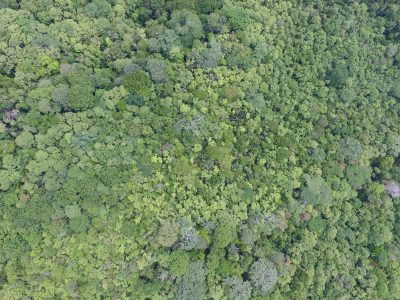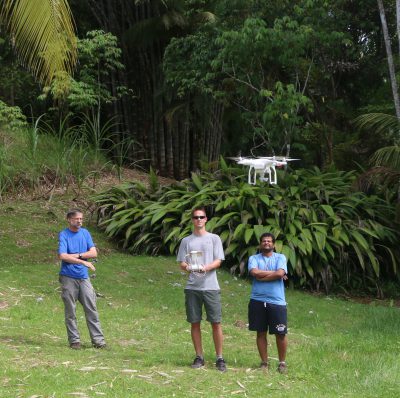 Aerial image by Andrew Marx and Ahmed Alzahrani
Aerial image by Andrew Marx and Ahmed Alzahrani
Claremont, Calif. (February 8, 2017)—Professor of Biology and Environmental Science Donald McFarlane has released data from a collaborative research project that used aerial drones to measure rates of reforestation at Pitzer College’s Firestone Center for Restoration Ecology in Costa Rica. The data, published in the article “UAV data for multi-temporal Landsat analysis of historic reforestation: a case study in Costa Rica,” reveals nearly total regrowth in the low-land tropical forest once cleared to raise cattle. The paper was published in the International Journal of Remote Sensing.
McFarlane and co-authors Andrew Marx, an assistant professor at Claremont Graduate University’s Center for Information Systems and Technology, and CGU doctoral student Ahmed Alzahrani describe how new data, culled from high-resolution images taken by an unmanned aerial vehicle (UAV), can be used in conjunction with data from historic, low-resolution satellite images of the 150-acre Firestone Center in southwest Costa Rica.
“The drone data, combined with Landsat data and findings from student research on the ground, gives us a 30-year record of land use change,” McFarlane said. “It’s important data for the Firestone Center and has potential use for much larger areas as well.”
Once blanketed by coastal primary-growth rainforest, the land that now makes up the College’s Firestone Center was cleared by cattle ranchers in the ’50s and ’60s. Environmentalist and philanthropist Diane Firestone initiated reforestation projects after she acquired the land in the early 1990s. She donated the property to Pitzer in 2005, giving the College a base for its semester-long study abroad program and a tropical ecological field station for undergraduate research.
For more than a decade, Pitzer students and professors have helped restore the forest by cutting back invasive species and planting native trees. They have also gauged the effects and rates of reforestation on the ecosystem by monitoring water quality, studying fruit-feeding butterflies, leaf-cutter ants and poison-dart frogs, and charting ecological changes using mapping software. The new paper shows the success of those efforts and the enormous benefit of protecting the land so it can heal on its own.
“Land that was cleared is now almost entirely vegetated in,” McFarlane said.
A graph in the paper shows a dramatic change in land cover since Firestone turned the land into a reserve. From 1993 to 2016, land cover skyrocketed from 8 percent to 93 percent.
 The techniques used by this intercollegiate research team (in addition to McFarlane, Marx and Alzahrani, the team included Claremont Colleges Library GIS Specialist Warren Roberts, wildlife biologist Keith Christenson and four students from the W.M. Keck Science Department of Claremont McKenna, Pitzer and Scripps colleges) can be incorporated by environmental land managers to plan and measure their own restoration efforts. Agile “quadcopter” drones mounted with multispectral cameras fill in information gaps left by aircraft and satellite imagery, especially in dense forest areas with a thick tree canopy, like the Firestone Center, which can interfere with GPS signals and make both aerial imaging and ground survey work very difficult.
The techniques used by this intercollegiate research team (in addition to McFarlane, Marx and Alzahrani, the team included Claremont Colleges Library GIS Specialist Warren Roberts, wildlife biologist Keith Christenson and four students from the W.M. Keck Science Department of Claremont McKenna, Pitzer and Scripps colleges) can be incorporated by environmental land managers to plan and measure their own restoration efforts. Agile “quadcopter” drones mounted with multispectral cameras fill in information gaps left by aircraft and satellite imagery, especially in dense forest areas with a thick tree canopy, like the Firestone Center, which can interfere with GPS signals and make both aerial imaging and ground survey work very difficult.
This coming summer, research will continue, using drones and Landsat images to measure drought stress in trees. Based on that data, McFarlane says the team will be able to “make predictions about how the forest may respond to future climate change.”
McFarlane has led numerous student research projects at Pitzer College’s Firestone Center for Restoration Ecology since the center opened in 2005. He began teaching tropical biology shortly after he arrived at the Keck Science Department in 1992, leading students on research trips to Costa Rica over spring break more than a decade before Pitzer established the Firestone Center. An awardee of multiple grants from the National Geographic Society’s Global Exploration Fund, McFarlane has published more than 100 articles on his many research interests, including the ecology of extinction, paleobiology and the ecology of cave ecosystems.
More information about Pitzer College’s Firestone Center and study abroad is available on the College’s website.